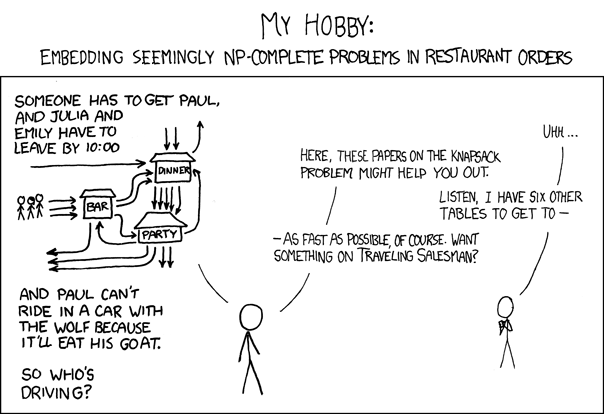Posted in Algorithm, coursera, intractability, P vs NP, NP completeness, search problem
Intractability
Comment

- What is a general-purpose computer?
- Are there limits on the power of digital computers?
- Are there limits on the power of machines we can build?
컴퓨터 과학자들이 computation 에 관해 질문해 온 것들이다. 이 문제에 답하기 위해 computation model 을 좀 살펴보자.

긴 테이프가 있고, 기계는 테이프를 하나씩 읽어 0인지 1 인지 판별한다. 여기서 읽는것 뿐만 아니라 출력까지 가능하면 turing machine 이 된다. 일종의 universal computation model 이다.

근데 놀랍게도 이것보다 더 진보한 연산 모델이 있느냐? 라는 질문에 대해 없음 이란 연구 결과가 나왔다고 한다.
Church-Turing thesis:
Turing machines can compute any function that can be computed by a physically harnessable process of the natural world.
여기서 thesis 인 이유는 증명이 아니기 때문이다. mathmatical theorem (정리) 가 아니다. 결국 이것이 의미하는 바는
- No need to seek more powerful machines or languages
- Enables rigorous study of computation (in this universe)
- Turing machine is a simple and universal model of computation
Church-Turing thesis 에 대해 80 년동안이나 반례가 발견되지 않았다. 그리고 수 많은 computation model 이 발견되었지만 모두 turing machine 과 동일한 것으로 밝혀졌다. (lambda caculus, URM, SKI 등)

일반적으로 useful algorithm 이란 모든종류의 입력 에 대해 polynomial time aN^b 시간 내에 풀 수 있는 것을 useful algorithm 이라 말한다.
polynomial time 알고리즘은 대부분 작은 a, b 를 가지기 때문에 다양한 문제로 적용하는것도 가능하다. 그러나 a, b 가 큰 경우 풀수 없는것과 마찬가지 일때도 있다.
Exponential growth dwarfs technological change
유용하지 않은 알고리즘의 예로, N 지점에 대한 TSP 는 brute force 를 이용하면 N! 이다.
얼마나 유용하지 않은가를 좀 더 생각해보자. 만들 수 있는 가장 큰 병렬 슈퍼컴퓨터를 가정 해보면
- Suppose you have a giant parallel computing device
- With as many processors as eletron in the universe
- And each processor has power of today's supercomputers
- ANd each processor works for the life of the universe
1000 도시의 TSP 를 brute force 로 풀려면, 이 병렬 슈퍼컴퓨터를 우주의 일생동안 돌려도 불가능하다.
1000! > 10^1000 > 10^79 * 10^13 * 10^17
이런 이유에서 어떤 문제가 polynomial time 내에 풀 수 없으면 intractable 하다고 말한다.
결국 우리가 풀 수 있는 문제는 poly-time algorithm 이 있는 경우이며, 어떤 문제가 이런 poly-time algorithm 을 가질까? 그건 쉽지 않다. 연구중이라고 함.
연구된 바로는 두 종류의 문제가 exponential time 일 것으로 본다.
- Given a constant-size program, does it half it at most K steps? (input size =
c + lgK) - Given
N-by-Ncheckers board position, can the first player foce a win?
Four fundamental problems
(1) LSOLVE: Given a system of linear equations, find a solution

가우시안 소거법으로 N-by-N 시스템에서 N^3 시간 안에 해결된다.
(2) LP: Given a system of linear inequalities, find a solution

Ellipsoid 알고리즘을 이용하면 poly-time
(3) ILP: Given a system of linear inequalties, find 0-1 solution

no poly-time algorithm known. 있을거 같긴 한데 모른다고 함
(4) SAT: Given a system of boolean equations, find a binary solution
no poly-time algorithm known 이것도 있을거 같긴 한데 모른다고 함
Search Problems
Given an instance
Iof a problem, find a solutionSor report none exists
답이 있거나, 없음을 말해줘야 하는데 이를 위해서 효율적으로 (poly-time) S 가 정답인지 검사할 수 있어야 한다.
위에서 본 LSOLVE, LP, ILP, SAT 문제 같은 경우 정답이 있으면 대입해서 poly-time 내에 검증할 수 있으므로 search problem 이다.
factor problem 도 search problem 이다. 주어진 n 비트 정수에 대해서, nontrivial factor 인지 아닌지는 나눠보면 되니까.
즉 search problem 에서는 답을 누군가 제공할때 그것이 답인지 아닌지를 poly-time 으로 검사할수 있냐 없냐가 중요하다.
NP
- NP: is the class of all search problems. (class definition limits NP to yes-no problem)
앞에서 본 LSOLVE, LP, ILP, SAT, FACTOR 모두 NP 다.
- P: is the class of search problems solvable in poly-time
LSOLVE, LP, SORT, STCONN 의 문제는 모두 P 다.
즉 답을 poly-time 내에 검증이 가능하면 NP 고, 거기에 답을 poly-time 내에 찾는것이 가능하면 P 란 이야기. P 가 중요한 이유는, 현실적으로 계산 가능한 문제이기 때문이다.
이론적으로는 1010401 * N ^(10^23) 도 계산 가능하다고 본다. 음!?!
Nondeterminism
Nondeterministic machine can guess the desired solution
regex 의 패턴매칭을 구현할때 했었던 NFA 처럼 일종의 nondeterministic machine 이 있다 하고, 이 기계가 답을 찾아준다고 하자. 예를 들면 이런 느낌이다.
int[] a = new int[N];
자바에선 0 으로 초기화 되는데, nondeterministic machine 을 이용하면 답으로 초기화 해주는 것이다.
DFA 를 NFA 로 바꾸었듯이, 같은 입력에 대해 다수의 상태를 가지도록 함으로써 튜링 머신(이하 TM) 도 쉽게 nondeterministic 로 만들 수 있다.
그러면 이제 NP 가 의미하는 바를 확실히 이해할 수 있다. nondeterministic polynomial time, 다시 말해 search problem 이 nondeterministic TM 위에서 poly-time 내에 풀 수 있다는 것이다.
(1) nondeterministic TM 이 답을 제공한다
(2) search problem 은 poly-time 내에 답인지 아닌지 판별이 가능하다.
조금 더 이해를 위해 위키를 인용하면
P는 결정론적 튜링 기계를 사용해 다항 시간 내에 답을 구할 수 있는 문제의 집합이고, NP는 비결정론적 튜링 기계를 사용해 다항 시간 내에 답을 구할 수 있는 문제의 집합이다. 여기에서 결정론적 튜링 기계에 사용한 프로그램을 비결정론적 튜링 기계에 적용할 수 있으므로, P는 NP의 부분집합이 된다. 하지만 여기에서 P와 NP가 같은 집합인지, 아니면 P가 NP의 진부분집합인지는 아직 밝혀지지 않았다. 현재 2000년에 클레이 수학연구소가 100만 달러를 걸었다.
Extended Church-Turing Thesis
이제까지 나온바를 정리하면
- NP: search problems solvable in poly-time on a nondetermimistic TM
그리고 extended Church-Turing thesis 에 의하면
- P: search problems solvable in poly-time in the natural world
따라서
- To make future computers more efficient, suffices to focus on impoving implementation of existing design
P vs NP
P = NP 일까? 이게 사실이라면, search problem 에서 exponential time 의 brute force 방법을 사용하지 않아도 된다. poly-time 알고리즘이 있다는 이야기니까.

(http://commons.wikimedia.org/)
P = NP 일 경우 nondeterministic TM 이 별 도움이 안된단 이야기고, P != NP 일 경우,
If no, Would learn something fundamental about our universe
대부분의 학자들은 P != NP 라 믿는다. 이는 non-deterministic TM 이 이전까지 우리가 사용했던 머신보다 더 강력하기 때문이라고 한다. 즉, 문제를 해결하기 위해 필요한 머신의 성능이 훨씬 좋아야 하므로 NP 가 P 와 같진 않을거라는 이야기
Classifying Problems
- SAT problem: Given a system fo boolean equations, find a solution

n 변수의 SAT 문제를 exhausitve search 로 풀면, 2^n 의 모든 경우를 다 시도 해봐야 한다. 더 빠른, poly-time 알고리즘으로 풀수는 없을까?
슬프게도 많은 학자들이 연구해 왔지만, 아직까지 발견되지 않았고 대부분의 학자들이 SAT 문제가 NP 라는 것에 동의한다. 증명되지 않았으므로 일종의 가정인데, 이 가정을 이용해 reduction 을 해 보자. 그럼 intractable 한 알고리즘을 찾아낼 수 있다.
Problem
Xpoly-time reduces to problemYIfXcan be solved with:
- Polynomial number of standard computational steps
- Polynomial number of calls to
Y
따라서 SAT 를 문제 Y 로 poly-time reduction 가능하면, Y 는 (거의) intractable 이다.
- If
Xcannot be solved in poly-time, thenYconnot be solved in *poly-time - If
Ycan be solved in poly-time, then so canX


NP-Completeness
An NP problem is NP-complete if all problems in NP poly-time reduce to it
즉 모든 NP 문제가 어떤 문제 A 로 poly-time reduction 이 되면 A 는 NP-complete 라는건데, Cook, 1971 에 의해 SAT 가 NP-complete 임이 증명되었다.
증명을 간단히 요약하면
- Convert non-deterministic TM notation to SAT notation
- If you can solve SAT, you can solve any problem in NP
일종의 reduction 이다.SAT 인스턴스를 poly-time 으로 풀면 non-deterministic TM 문제로 풀 수 있는 NP 문제도 poly-time 으로 풀수 있게된다.
- SAT 를 poly-time 으로 풀면
P = NP - NP 문제에 대해 poly-time 알고리즘이 없으면 SAT 에 대해서도 없다.


많은 문제가 NP-complete 다.
Coping With Intractability
암호학 같은 경우 intractability 가 널리 쓰인다. RSA 의 경우
- To use: multiply two
n-bit integers (poly-time) - To break: factor a 2
n-bit integer (unlikely poly-time)
근데 1994년에 양자 컴퓨터로는 n 비트 FACTOR 문제가 n^3 안에 풀릴 수 있다는 가설이 제기되었다. 그럼 실 세계에서는 P 만 poly-time 으로 풀린다는 extended Church-Turing thesis 는..
아무튼 intractability 를 해결하기 위해서 쓸 수 있는 몇 가지 테크닉이 있다.
(1) Solve arbitrary instances of the problem
specialc cases 는 tractable 일 수 있다. 예를 들어 2-SAT 은 linear time 이다.
(2) Solve the problem to optimality
heuristic 을 이용해 알고리즘을 만드는 방법도 있다. 최적은 아니지만 좋은 결과를 낼 수도 있기 때문이다. (TSP assigment heuristics)
그리고 대부분 좋은 결과를 돌려주는 approximation algorithm 을 이용할 수도 있다. MAX-3SAT 은 87.5% 는 보장한다고 함.
(3) Solve the problem in poly-time
Complexity theory deals with worst case behavior
Hamilton path
해밀턴 경로의 경우 모든 정점을 한번씩 방문해야 하는데, NP-complete 문제라고 한다. 오일러 경로(edge) 는 쉽다고 함.
exponential time 으로 구현할 수 있다. 일반 DFS 와 다른점은 clean up 부분.
public class HamiltonPath
{
private boolean[] marked; // vertices on current path
private int count = 0; // number of Hamiltonian paths
public HamiltonPath(Graph G)
{
marked = new boolean[G.V()];
for (int v = 0; v < G.V(); v++)
dfs(G, v, 1);
}
//depth is the length of current path (depth of recursion)
private void dfs(Graph G, int v, int depth)
{
marked[v] = true;
if (depth == G.V()) count++;
for (int w : G.adj(v))
if (!marked[w]) dfs(G, w, depth+1); //backtrack if w is already part of path
marked[v] = false; // clean up
}
}
Summary
- P: Class of search problems solvable in poly-time
- NP: Clas of all search problems, some of which seem wickedly hard
- NP-complete: Hardest problems in NP
Intractable: Problem with no poly-time algorithm
A poly-time algorithm for an NP-complete problem would be a stunning breakthrough (a proof that
P = NP)- You will confront NP-complete problems in your career
- Safe yo assume that
P != NPand that such problem are intractable - Identify these situations and proceed accordingly
References
(1) Algorithms: Part 2 by Robert Sedgewick
(2) http://introcs.cs.princeton.edu
(3) Lecture note: intractability
(4) xkcd image
(5) Turing machine image
(6) Wikipedia: P-NP 문제